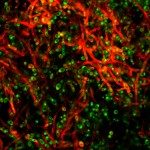Link to Pubmed [PMID] – 22044600
Clin. Microbiol. Infect. 2012 Nov;18(11):1117-25
All organisms usually isolated in our laboratory are now routinely identified by matrix-assisted laser desorption ionization-time of flight mass spectrometry (MALDI-TOF MS) using the Andromas software. The aim of this study was to describe the use of this strategy in a routine clinical microbiology laboratory. The microorganisms identified included bacteria, mycobacteria, yeasts and Aspergillus spp. isolated on solid media or extracted directly from blood cultures. MALDI-TOF MS was performed on 2665 bacteria isolated on solid media, corresponding to all bacteria isolated during this period except Escherichia coli grown on chromogenic media. All acquisitions were performed without extraction. After a single acquisition, 93.1% of bacteria grown on solid media were correctly identified. When the first acquisition was not contributory, a second acquisition was performed either the same day or the next day. After two acquisitions, the rate of bacteria identified increased to 99.2%. The failures reported on 21 strains were due to an unknown profile attributed to new species (9) or an insufficient quality of the spectrum (12). MALDI-TOF MS has been applied to 162 positive blood cultures. The identification rate was 91.4%. All mycobacteria isolated during this period (22) were correctly identified by MALDI-TOF MS without any extraction. For 96.3% and 92.2% of yeasts and Aspergillus spp., respectively, the identification was obtained with a single acquisition. After a second acquisition, the overall identification rate was 98.8% for yeasts (160/162) and 98.4% (63/64) for Aspergillus spp. In conclusion, the MALDI-TOF MS strategy used in this work allows a rapid and efficient identification of all microorganisms isolated routinely.
